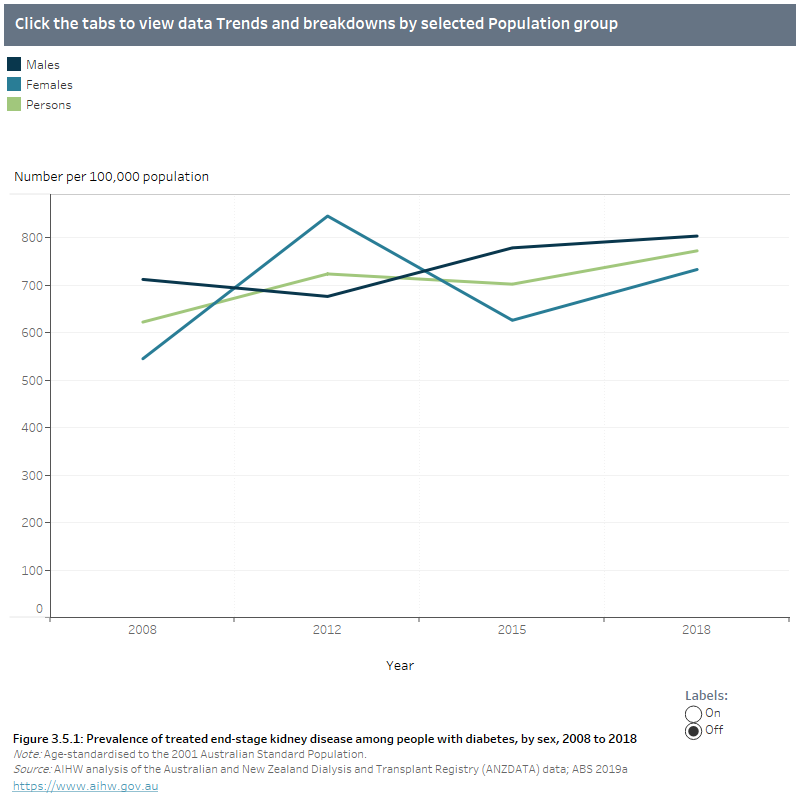Indicator 3.5 Prevalence of end-stage kidney disease among people with diabetes
Considerations
- This is a proxy measure based on the prevalence of treated end-stage kidney disease (ESKD) from the Australia and New Zealand Dialysis and Transplant Registry (ANZDATA) and the total population of people with self-reported diabetes from the ABS National Health Survey (NHS).
- This method is likely to underestimate the total population of people with diabetes as some people are unaware they have the condition. In 2011–12 the ABS found that, based on biomedical data, around 1 in 5 people with diabetes were unaware that they had the condition (ABS 2013). In addition, the prevalence of ESKD is likely underestimated, with approximately 50% of people with ESKD remaining untreated (Lim et al. 2019).
Overview
An estimated 10,400 people with diabetes had treated end-stage kidney disease — 884 per 100,000 population in 2018.
Trends
After adjusting for age, the estimated prevalence of treated end-stage kidney disease among people with diabetes increased from 623 per 100,000 population in 2008 to 773 per 100,000 population in 2018 (Figure 3.5.1).
Age and sex
Males had a higher age-standardised prevalence rate than females (804 and 733 per 100,000 population, respectively) and, by age, the rate was highest among those aged 45–54 (1,200 per 100,000 population) in 2018 (Figure 3.5.2).
Population groups
By remoteness area, the prevalence was lowest in Major cities and Inner regional areas (695 and 733 per 100,000 population, respectively) and highest in Outer regional/Remote areas (1,500 per 100,000 population). The prevalence of treated end-stage kidney disease among people with diabetes ranged from 571 per 100,000 population to 1,100 per 100,000 population across the socioeconomic areas (Figure 3.5.2).
State and territory
Rates of treated end-stage kidney disease among people with diabetes varied by state and territory from 624 per 100,000 population in Victoria to 5,800 per 100,000 in the Northern Territory (Figure 3.5.2).
Aboriginal and Torres Strait Islander people
In 2018, an estimated 1,700 Indigenous Australians with diabetes had treated end-stage kidney disease, equating to 2,700 per 100,000 population (the estimated number of people with self-reported diabetes from the 2018–19 National Aboriginal and Torres Strait Islander Health Survey).
Explore the data
3.5 Prevalence of treated end-stage kidney disease among people with diabetes, 2008–2018 and by selected population group, 2018
Trends figure 3.5.1 shows the increasing prevalence of treated end-stage kidney disease among people with diabetes from 2008 to 2018. Prevalence increased from 623 per 100,000 population in 2008 to 773 per 100,000 population in 2018.
Population group figure 3.5.2 shows in 2018 the prevalence of treated end-stage kidney disease among people with diabetes was slightly higher among males than females across all age groups. Prevalence was highest among males and females aged 45-54 at 1,200 per 100,000 population. Prevalence rates were higher among Indigenous females than Indigenous males at 2,900 and 2,400 per 100,000 population, respectively. Rates varied by socioeconomic area and were two times as high in Outer regional and remote areas as Major cities. Among the states and territories, the prevalence of end-stage kidney disease among people with diabetes was highest in the Northern Territory (5,800 per 100,000 population) and lowest in Victoria (624 per 100,000 population).

|
|
Definition |
Data source |
|---|---|---|
|
Numerator |
Number of treated end-stage kidney disease cases with diabetes. |
ANZDATA 2018 |
|
Denominator |
Estimated number of adults (18+ years) with self-reported diabetes. Included people with type 1 diabetes, type 2 diabetes, and type unknown. |
ABS 2019a; ABS 2019b ; ABS 2016; ABS 2013; ABS 2009 |
Australian Bureau of Statistics (ABS) 2009. Microdata: National Health Survey, 2007–08. ABS cat. no. 4324.0.55.001. Findings based on Expanded Confidentialised Unit Record File analysis. Canberra: ABS.
ABS 2013. Microdata: Australian Health Survey, National Health Survey, 2011–12. ABS cat. no. 4324.0.55.001. Findings based on Detailed Microdata analysis. Canberra: ABS.
ABS 2016. Microdata: National Health Survey, 2014–15. ABS cat. no. 4324.0.55.001. Findings based on Detailed Microdata analysis. Canberra: ABS.
ABS 2019a. Microdata: National Health Survey, 2017–18. ABS cat. no. 4324.0.55.001. Findings based on Detailed Microdata analysis. Canberra: ABS.
ABS 2019b. Microdata: National Aboriginal and Torres Strait Islander Health, Australia, 2018–19. ABS cat. no. 4715.0.55.001. Findings based on Detailed Microdata analysis. Canberra: ABS.
Lim WH, Johnson DW, McDonald SP, Hawley C, Clayton PA, Jose MD et al. 2019. Impending challenges of the burden of end‐stage kidney disease in Australia. Medical Journal of Australia 211(8).


